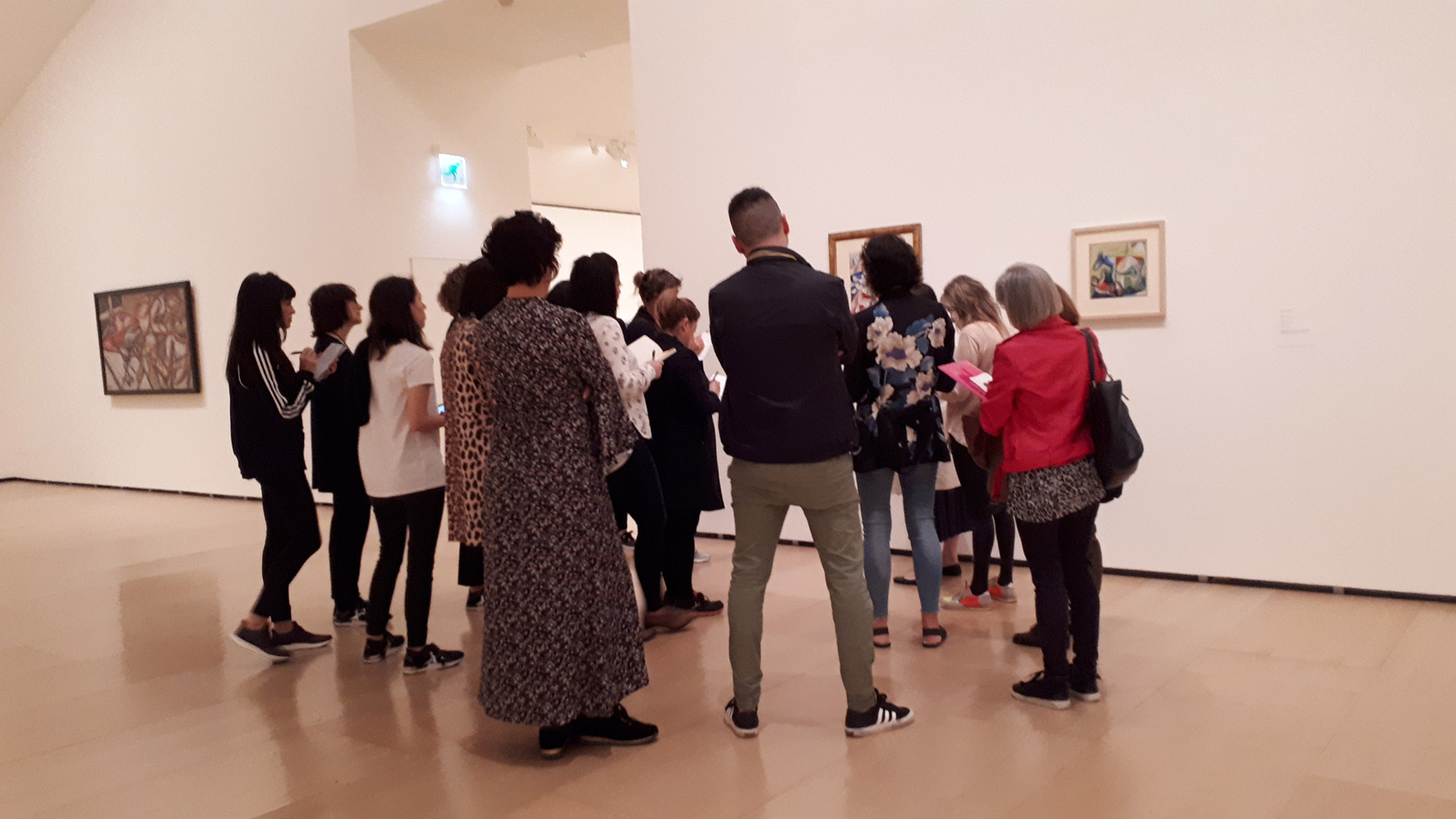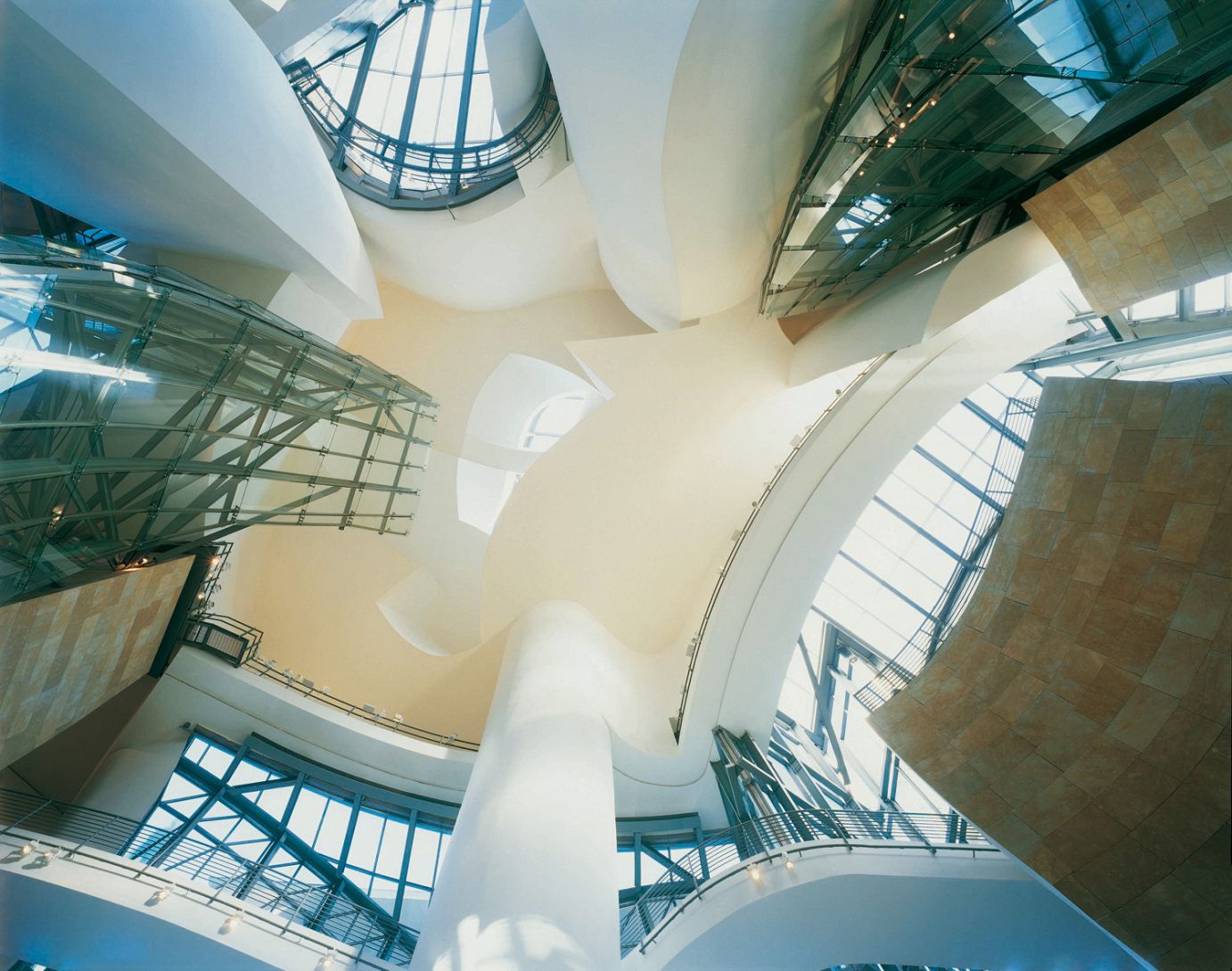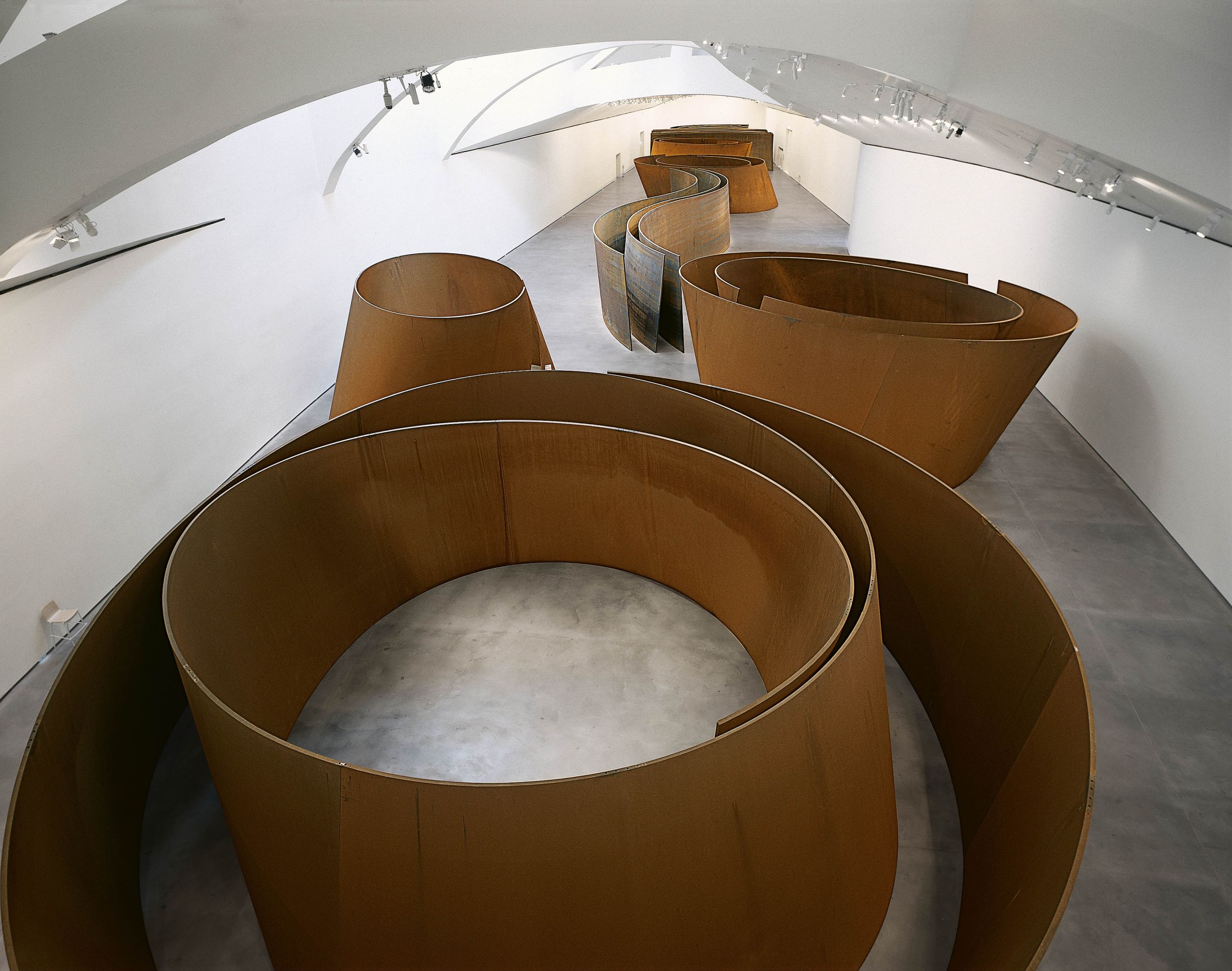
Art & fun
Welcome to the Guggenheim Museum Bilbao!
Can art help us understand what we feel?
This self-guided tour will take you to some artworks in the Museum Collection that most visitors find inspiring, amusing, and enjoyable. Maybe you will feel the same about them… The selection is based on the results of ARTETIK: From the Art, a digital experiment in art and emotions. You can be part of the experiment too!
We hope you find the tour rewarding!

The Matter of Time
Gallery 104, level 1
Enter the Museum, get to the Atrium and go to Gallery 104, where you will find Richard Serra’s monumental installation The Matter of Time – one of his most ambitious projects.
Born in the United States, Serra is one of the most influential artists of the twentieth- and twenty-first centuries. His abstract sculptures reveal their manufacturing history and the properties of the materials of which they are made – in this case, weathering steel, which the artist learned to handle when he worked in a steel mill. With the aid of the CATIA software, Serra designed a series of large-scale sculptures based on geometric shapes: ellipses, spirals, spheres, tori, cones, etc.
Visitors are encouraged to walk around the gallery, skirting the sculptures and getting inside. The eight pieces that make the installation were designed to involve the huge gallery where they are displayed. The experience is both spatial and temporal in nature – and different for everyone.
What can you feel when you walk around The Matter of Time? How would you describe your sensations?
At the far end of the gallery, there is an educational area containing a model of Serra’s installation, as well as other resources.
Richard Serra
The Matter of Time, 1994-2005
Weathering steel
Dimensions variable
Guggenheim Bilbao Museoa
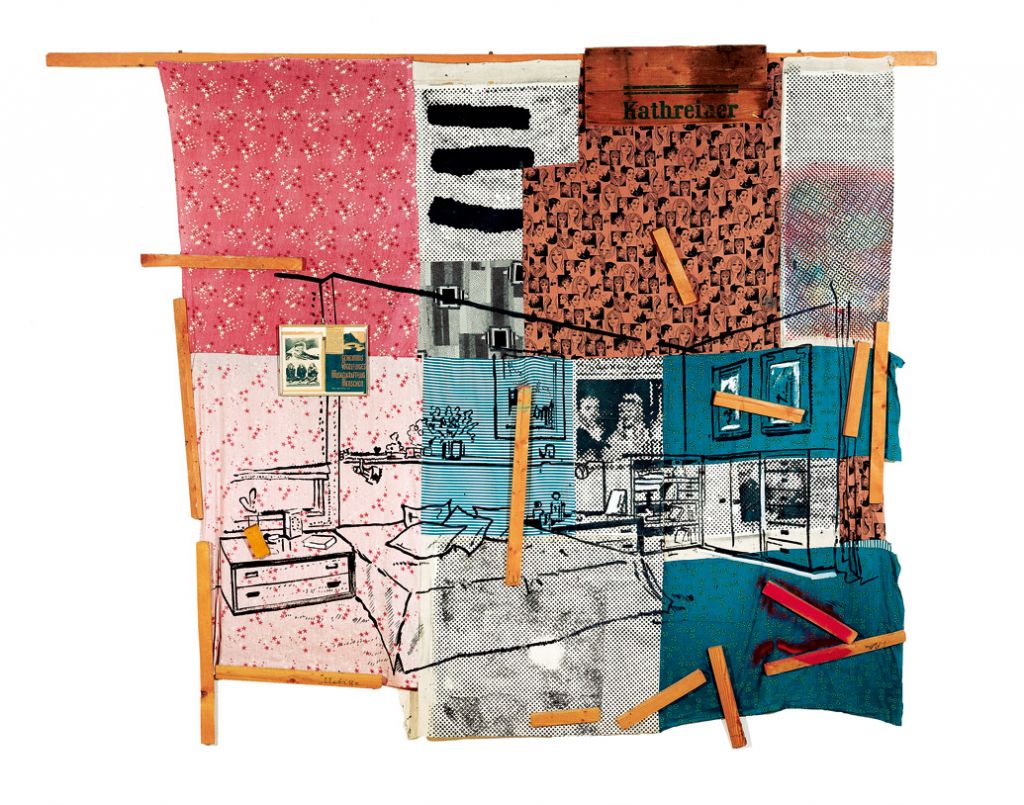
Kathreiner’s Morning Wood
Gallery 202, level 2
German artist Sigmar Polke took an experimental approach to painting, often resorting to unconventional materials and techniques, and inserting media images in his works. Associated with Pop Art and Capitalist Realism, he dealt with political and social issues in his work. His style, which blurs the line between figuration and abstraction, is characterized by the use of bright colors and repetitive patterns.
In Kathreiner’s Morning Wood, Polke “dismantles” easel painting by inserting fragments of a wooden frame in the surface of his work. By inverting his own name and signing as “Henri Matisse” in the bottom left corner, he ironizes on the need for an artwork to be signed in order to guarantee its authenticity and therefore its value. In this way, he criticizes the status of the artist and hints at the impossibility of sustained originality in contemporary art.
What can you see in Kathreiner’s Morning Wood? What is the artist trying to tell us with the images he has inserted in his painting?
Sigmar Polke
Kathreiner’s Morning Wood (Kathreiners Morgenlatte), 1969-79
Acrylic, wood, mixed media, and framed collage on canvas and fabric
235 x 305 cm
Guggenheim Bilbao Museoa

Waking
Gallery 303, level 3
Gilbert and George met in the 1960s. They soon moved together and began to work together, merging their identities to become Gilbert & George. They make no distinction between art and life: their lives are their own works of art. In the late 1960s, they conceived their “Living Sculptures”, which transformed their everyday activities into performance art.
Gilbert & George have tried a variety of disciplines, including painting, drawing, photography, writing, film, and performance. In all of them, the artists take center stage, often in the form of self-portraits.
In the mid-1970s, the artists adopted the grid format for their photographic works, while in the early 1980s, they began to dye collaged photographs with lurid colors, thereby playfully summoning the tradition of stained-glass windows in churches. Both features can be appreciated in Waking.
Their works from this period draw upon the particulars of East End society and the British urban homosexual experience, but do so in order to engage the full range of human existence.
Gilbert & George
Waking, 1984
Photo-piece
363 x 1111 cm
Guggenheim Bilbao Museoa

Tulips
Gallery 303, level 3
In the same gallery, you can take a look at Tulips, a work by American artist Jeff Koons.
Back in the 1980s, Koons defied the limits between highbrow and popular culture by using a visual language that drew on marketing, advertising, and the entertainment industry to reach across to the so-called masses.
Tulips is a bouquet of multicolor balloon flowers blown up to gargantuan proportions (more than 2 meters tall and 5 meters across). It belongs to Koons’s Celebration series, which he initiated in 1994. Focusing on the kinds of generic, mass-produced objects associated with birthday parties, holidays, and other festive events, the paintings and sculptures in the series reflect Koons’s continued engagement with the emblems of childhood.
In Tulips, as in the towering Puppy, which stands in the Museum Square, Koons has manipulated scale and materials to uncanny ends. What do you think is the artist’s intended effect on the viewer?
Jeff Koons
Tulips, 1995-2004
High chromium stainless steel with transparent color coating
203 x 460 x 520 cm
Guggenheim Bilbao Museoa
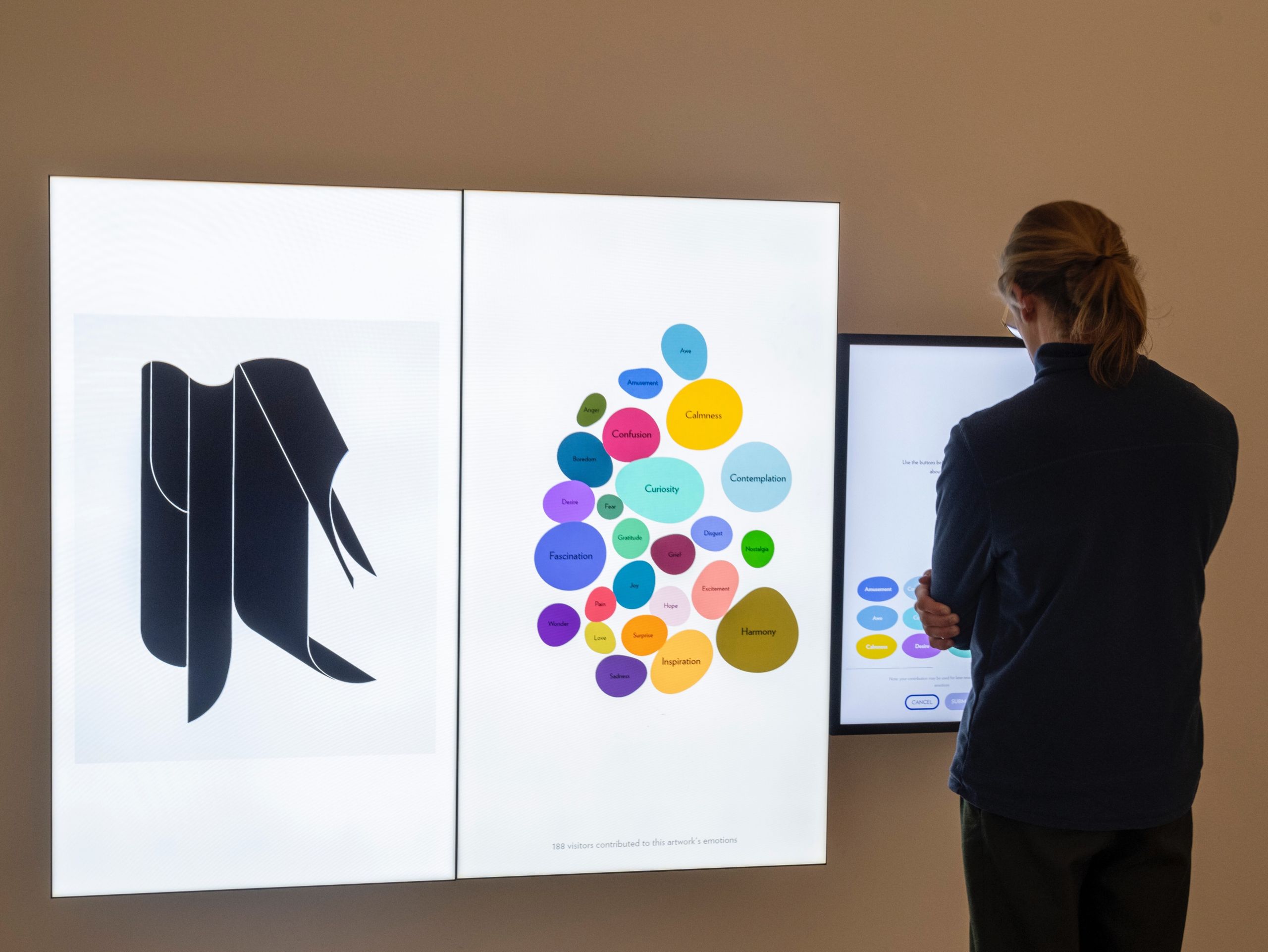
ARTETIK: From the Art
Hallway next to Gallery 303
How do you feel when you look at a work of art? Do you think other people feel the same? ARTETIK: From the Art is a digital experience you cannot afford to miss!
ARTETIK is an installation to explore the emotions triggered by the works in the Guggenheim Museum Bilbao Permanent Collection. It is a digital experience to be completed over the course of time, creating a collective emotion chart from the interactions with individual visitors.
Experience art in the Museum Collection and share your emotions! You can also explore other works arousing fascination and other feelings in the viewer.
ARTETIK: From the Art is a project carried out by the Guggenheim Museum Bilbao and Google Arts & Culture.

Puppy
Museum Square
Upon leaving the Museum, you will come across Jeff Koons’s Puppy. In Puppy, Koons brings past and present together, evoking eighteenth-century European gardens and their theatrical effects while using sophisticated computer models for the large-scale structure. His giant West Highland white terrier sculpture, covered in plants, is a monument to sentimentalism, conveyed in the form of tender icons: flowers and puppies.
In Puppy, Koons plays with scale and combines references to both highbrow and popular culture, from the art of bush sculpture to dog breeding to decorative ceramics to greeting cards.
Koons designed his Puppy to attract visitors, instill optimism, and make people feel “confident and secure” (in the artist’s own words). Distinguished and robust, Puppy keeps watch of the Museum, as visitors look at him with wonder and joy. With time, Jeff Koons’s dog has become an icon of Bilbao.
Did you know? Puppy is a “living” work of art. It is covered with 35,000 flowering plants: in spring, begonias, impatiens, petunias, lobelias, Indian and Chinese carnations in red, orange, pink, and white; in the fall, pansies.
Jeff Koons
Puppy, 1992
Stainless steel, soil, and flowering plants
1240 x 1240 x 820 cm
Guggenheim Bilbao Museoa
This is the end of your tour. The works in this itinerary are but a few examples of art with which you can have fun. There are many more, of course. Just follow your own path around to spot others, and have fun with art!
We hope you have enjoyed the experience. See you again soon!

